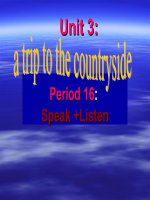- Trang chủ >>
- THPT Quốc Gia >>
- Hóa
Redwoods and sequoias
Bạn đang xem bản rút gọn của tài liệu. Xem và tải ngay bản đầy đủ của tài liệu tại đây (8.2 MB, 12 trang )
Life Sciences
by Donna J. Watson
Genre
Nonfiction
Comprehension Skill
Cause and Effect
Text Features
• Captions
• Glossary
Science Content
How Living Things
Survive
Scott Foresman Science 4.5
ISBN 0-328-23555-5
ì<(sk$m)=cdf fb< +^-Ä-U-Ä-U
Vocabulary
Extended Vocabulary
adaptation
community
competition
pollination
population
seed dispersal
banana slug
burl
family circle
firestorm
grove
lower montane forest
northern spotted owl
tannin
transpiration
Picture Credits
Every effort has been made to secure permission and provide appropriate credit for photographic material. The
publisher deeply regrets any omission and pledges to correct errors called to its attention in subsequent editions.
Unless otherwise acknowledged, all photographs are the copyright of Dorling Kindersley, a division of Pearson.
2 Minden Pictures; 3 Digital Vision; 4 Carr Clifton/Minden Pictures; 5 Getty Images; 6 Ken Lucas/Visuals Unlimited;
7 Getty Images; 8 Kent, Breck P./Animals Animals/Earth Scenes; 9 Getty Images; 10 Raymond Gehman/National
Geographic Image Collection; 11 (Inset) Getty Images, John Gerlach/Visuals Unlimited; 12 David Muench/Corbis;
13 Getty Images, Rokeach Aerial Photography, Barrie/Getty Images; 14 Getty Images; 16 Ryan Baldwin/Animals
Animals/Earth Scenes; 17 (Inset) Nature Picture Library, David Kjaer/Nature Picture Library; 18 (BL) Peter Chadwick/DK
Images, (BR) ©Peter/Georgina Bowater/Mira; 19 Rich Reid/National Geographic Image Collection.
ISBN: 0-328-23555-5
Copyright © Pearson Education, Inc. All Rights Reserved. Printed in the United States of America.
This publication is protected by Copyright, and permission should be obtained from the publisher prior to any
prohibited reproduction, storage in a retrieval system, or transmission in any form by any means, electronic,
mechanical, photocopying, recording, or likewise. For information regarding permission(s), write to
Permissions Department, Scott Foresman, 1900 East Lake Avenue, Glenview, Illinois 60025.
1 2 3 4 5 6 7 8 9 10 V010 13 12 11 10 09 08 07 06
by Donna J. Watson
What You Already Know
Ecosystems contain many different kinds of plants, birds,
insects, mammals, reptiles, and amphibians. These living
things make up different populations within ecosystems. A
population is all of the same kind of living things that live in
one place. All of the different populations in that place make
up a community.
When two or more living things must use the same
limited resources, competition occurs. Certain adaptations
can help living things reduce competition. An
adaptation is a trait that helps a living
thing survive in its environment.
These squirrels make
up a population in the
ecosystem.
2
Pollination is the movement of pollen from a male part of
a flower to a female part. Some bats, birds, and insects spread
pollen as they feed at plants. After pollination, a plant is able
to form seeds. Through seed dispersal, or seed scattering,
those seeds may be spread far from the parent plant.
This book describes California’s coastal redwoods and
giant sequoias. Thousands of tourists visit California’s forests
each year to admire these trees. But these huge trees are
threatened by logging, development, and other factors.
Keep reading to find out more about redwoods
and sequoias!
This bee is pollinating a plant’s flower.
Bats and birds also pollinate flowers.
3
What’s in a Name?
Before anything, we need to define “redwood” and
“sequoia.” People use different names for these trees. The
names can cause people to confuse one tree with the other.
Even now, the same species of tree may have a different name
in one reference source than it has in another.
So here is what you need to know. This book is mainly
about the coastal redwood. This tree is sometimes called
the “California redwood,” or just the “redwood.” But “coastal
redwood” is the name used most often.
This book is also about the giant sequoia. This tree is
sometimes called the “big tree,” “Sierra redwood,” or just
“sequoia.” The name “Sierra redwood” might lead someone to
think that the giant sequoia is simply a different
kind of coastal redwood. But it is a
totally different kind of tree.
Coastal redwoods are
also called “California
redwoods.”
4
Coastal redwoods and giant sequoias have many
differences. They also have many things in common. Giant
sequoias and coastal redwoods belong to the same family of
trees. They are both found in California. Giant sequoias and
redwoods have similar branches. Their bark, shape, and color
are also similar. Both trees make new trees by dropping cones
that carry seeds. And both the coastal redwood and the giant
sequoia grow to be very big and tall!
People can confuse sequoias and coastal redwoods
because of everything they have in common. The history of
their scientific names has also caused confusion. At one point
the giant sequoia had the same scientific name as the coastal
redwood! It was not until the 1930s that the trees’ scientific
names were finalized.
These giant sequoias grow
in California’s Yosemite
National Park.
5
Sequoias and Redwoods Over Time
Millions of years ago, North America’s climate was
milder and wetter. Sequoias and redwoods grew far beyond
their current range. Scientists know this because of redwood
leaf fossils they have discovered on Axel Heiberg Island in
northeastern Canada. The island is thousands of kilometers
north of today’s redwood forests. But millions of years ago,
redwoods grew all over the island.
Eventually, redwoods stopped growing on Axel Heiberg
Island. North America’s climate became colder and drier.
California’s Sierra Nevada rose. These mountains block a lot
of rain from falling east of California. Finally, over the last
million years, glaciers spread back and forth repeatedly across
North America. The glaciers, Sierra Nevada, and climate
change caused the deaths of many of sequoias,
redwoods, and related trees.
This redwood leaf fossil,
found in Oregon, dates back
about 50 million years.
6
Today, coastal redwoods grow only in northern California
and part of southern Oregon. Giant sequoias grow only on
the western slopes of the Sierra Nevada.
Coastal redwoods live at lower elevations, where it is
foggier and rainier. They prefer mild temperatures. Giant
sequoias live at higher elevations that get more snow. They
can survive in more extreme temperatures.
Redwoods and sequoias are protected in many California
parks and forests. Some of these places are famous, such as
Yosemite National Park. Many giant sequoias grow there.
Sequoias also grow in the Sequoia and Kings Canyon National
Parks. The parks that protect redwoods include Redwood
National Park, Jedediah Smith Redwoods State Park, and
Humboldt Redwoods State Park.
Redwoods in California’s
Redwood National Park. Millions
of years ago, redwoods did not
have to share space with roads!
7
The Giant Sequoia
The giant sequoia grows to “only” 90 meters in height.
This makes it slightly shorter than the coastal redwood.
However, it grows much bigger and heavier than the coastal
redwood. Giant sequoias are the world’s largest living things.
They are also the world’s second-oldest living things, after the
bristlecone pine tree.
So just how large and how old are the giant sequoias? The
largest have a circumference of between 25 and 35 meters and
a volume of between 1,100 and 1,400 cubic meters. Sequoia
National Park’s General Sherman tree is the largest known
sequoia. It weighs over 6,000 tons! Most reference sources say
that sequoias can live for up to 3,000 years. A few sources say
they can live for an amazing 4,000 years.
The General Sherman giant
sequoia (right) is thought to be
the largest living thing on Earth.
The tree is 84 meters tall.
8
The giant sequoia grows in the lower montane forest of
the western Sierra Nevada. This forest grows at elevations of
900 to 2,000 meters. The lower montane forest is low enough
to be protected from the cold, windy weather of the Sierra
Nevada’s high peaks. But it is high enough to get plenty of
snow in the winter and rain in the spring and fall.
The lower montane forest includes several other kinds of
trees. Among them are Douglas fir, Jeffrey pine, red fir, and
California black oak. Animals such as black bears, mule deer,
bobcats, king snakes, white-headed woodpeckers, and many
kinds of bats live in the lower montane forest.
The rock wall of El Capitan (left) rises
above Yosemite National Park’s
lower montane forest, where
animals such as mule deer
(below) are found.
9
Sequoias and Fire
Giant sequoias grow near one another in groves. Only
about 70 groves of giant sequoia remain in California. Thirtyeight are found in the parks that make up Sequoia National
Forest. Sheepherding, development, and forest fires have
reduced the number of giant sequoias.
Of these factors, forest fires have had the most impact.
You may be surprised to learn that sequoia groves need many
small forest fires to grow new trees and stay healthy. The heat
from forest fires causes sequoias’ seeds to fall to the ground.
Forest fires also destroy smaller trees, as well as twigs and
leaves that have fallen to the forest floor. This frees up space,
sunlight, water, and other resources for young sequoias. Ash
from forest fires also contains many minerals and nutrients
that help sequoias grow.
This fire was set on purpose to
help grow new giant sequoias.
10
By preventing forest fires, we have allowed sequoia groves
to become choked with smaller trees. These trees can cause
a small fire to turn into a firestorm. Fire may also keep insect
pests, such as carpenter ants, from hurting sequoias.
Fire helps keep sequoia forests healthy and helps young
sequoias grow. But fire can also damage them. Another way
sequoias have adapted is to have very thick bark that doesn’t
burn easily. In places it is a foot thick!
Sequoias have other adaptations. Both the longhorn
beetle and Douglas squirrel help sequoias release their seeds.
The beetles burrow into sequoia pinecones. The squirrels
eat sequoia pinecones. Both animals help the pinecones to
disperse their seeds. In this relationship, the tree and the
animal benefit. The animal gets food or shelter. The tree gets
its seeds scattered.
Sequoia bark (left) is adapted to be fire
resistant. Fire keeps the carpenter ant
(below) from hurting sequoias.
11
Redwoods’ Needs
Coastal redwoods are the world’s tallest trees. They
grow to over 90 meters. A coastal redwood of California’s
Humboldt Redwoods State Park, the Stratosphere Giant,
stands 113 meters tall! What helps redwoods grow so tall?
Redwoods grow best in places with mild temperatures,
lots of rain or fog, shelter from the wind, and moist soil.
Let’s start with the need for mild temperatures. The Pacific
Ocean keeps the weather in northern California mild. For
example, San Francisco’s average temperature is 14°C. Even
on the warmest days it is rarely warmer than 21°C. And the
temperature almost never drops below 4°C.
Redwoods would grow faster in Southern
California, where there is more sunlight.
But they could not survive the hot
summers and lack of rain.
This redwood grows in
California’s Humboldt
Redwoods State Park.
12
Rain and Fog
Coastal redwoods need a lot of rain and fog. Northern
California averages about a hundred inches of rain a year. It
is frequently covered in fog. The Pacific Ocean helps create
northern California’s rain and fog.
Coastal redwoods need the moisture in the fog to stay
alive during the drier summer months. Without it, they
would lose a large amount of water. The water would be lost
through evaporation from the surrounding environment and
transpiration from their leaves.
Fog that touches a redwood’s needles condenses. That
means it changes into water droplets. The droplets drip from
the needles and soak into the soil. The redwood’s root system
then takes in the water.
Both pictures show
redwoods covered in fog
in Redwood National Park.
13
Soil and Shelter
Coastal redwoods need moist soil because they do not
have a taproot. A taproot grows deep into the ground and
helps the tree absorb groundwater. The seeds of the coastal
redwood also need very moist soil in order to grow.
Redwoods grow in river valleys and floodplains, where the
soil is moist. The water table in river valleys and floodplains is
very high. Roots of trees that grow in these areas do not have
to reach as far into the soil to take in water.
River valleys and floodplains are found at the lowest
points of land. This protects the redwoods from the strong
winds that blow in the surrounding hills. It also protects them
from the severe weather that flows off the Pacific
Ocean.
To the right is Yosemite
National Park’s Merced River
Valley. Below are trees in
northern California’s Redwood
Creek river valley.
14
Despite their name, coastal redwoods do not grow along
the Pacific coast. Their home is actually 8 to 65 kilometers
inland. They lack deep root systems, so coastal redwoods are
not anchored in the ground as firmly as other trees. Coastal
winds are too strong and would cause them to topple over.
Also, the soil along the coast is too rocky and sandy, and the
air is too full of the ocean’s salt spray.
Trees such as the Sitka spruce can survive in the Pacific
coast’s sandy and rocky soil. They, other plants, and the
beaches and dunes protect coastal redwoods from Pacific
Ocean weather. The redwoods still receive the rain and fog
that roll in off the ocean. But because they are farther inland,
they are protected from some very nasty conditions.
Trees in Redwood National Park
(below and left) have to face the
Pacific Ocean’s strong winds.
15
Among the Redwoods
So far you have read about how redwoods stay protected
by growing inland. Redwoods also stay protected by growing
around other redwoods.
A large grove of redwoods catches more water than a
small grove of redwoods, or just one redwood growing alone.
Rain and fog will more often go around a lone redwood,
causing it to miss out on vital moisture. Larger redwood
groves also absorb more groundwater.
Single redwoods have problems with wind. Big groves of
closely spaced redwoods form a barrier to the wind.
For these reasons, redwoods have a hard time living far
from other redwoods. When the trees on the edge
of a redwood grove die, their neighbors
often die, as well.
These redwoods growing in a
grove. Groves form barriers
to the wind and absorb
lots of groundwater.
16
Redwoods have an amazing ability to grow new
redwoods. Wind, water, and certain animals carry redwood
seeds throughout the forest community. New redwoods can
also sprout from the trunk of a damaged redwood. Redwood
seedlings can grow from the roots of a fallen redwood.
New redwoods can also spring up from the base of a
redwood stump. These new trees grow in a circle around the
stump. They are often referred to as a “family circle.” With the
old tree gone, the new trees do not have to compete with it
for sunlight, space, soil, or water. This allows the new trees to
grow quickly. In the competition for limited resources, some
of the young trees will grow taller and live longer than the
others.
California’s Muir Woods National
Monument has young redwoods
growing among adult redwoods
(left). This young redwood
(below) is growing in
Redwood National Park.
17
Redwood Adaptations
Redwoods also grow burls, which are knotty growths on
their bark. If the main tree is ever damaged, diseased, or dying,
the burl can sprout a new tree. The burl remains on the tree’s
trunk until the tree causes it to start growing.
Redwood bark contains tannin, which helps keep insects
and fungi away. The bark is also very thick. It stops most
forest fires from reaching the inner part of the tree.
Redwoods have adaptations involving other living things.
One type of fungus has developed a symbiotic relationship
with the redwood. Neither the fungus nor the redwood can
live without the presence of the other. The fungus lives in the
soil around a redwood. It helps the tree take in nutrients from
the soil.
Below is a cross-section of redwood
bark. The trees on the right were
burned in a forest fire, but their
bark prevented major damage.
18
Many living things depend on redwoods. Mushrooms
and fungi live in fallen redwoods. They provide food for the
banana slug and other animals. Fallen redwoods also provide
shelter for Pacific tree frogs, Pacific giant salamanders, and
the northern rough-skinned newt. Birds such as the marbled
murrelet nest in redwoods. Northern spotted owls live in the
hollows of older redwoods.
Giant sequoias and coastal redwoods face an uncertain
future. Logging threatens unprotected coastal redwoods,
while huge forest fires and a lack of small forest fires hurt
giant sequoias. Unprotected sequoias and redwoods are both
threatened by development. There are several groups that
work to protect coastal redwoods and giant sequoias. Use
your library’s media resource center to find out more!
The banana slug (left) lives
off of the mushrooms and
fungi that grow in fallen
redwoods.
19
What did you learn?
Glossary
banana slug
a mollusk of the redwood forest
burl
a knotty growth on redwood
bark that can sprout into a new
redwood
family circle
a cluster of young redwoods
growing around the stump of a
redwood that has been cut down
firestorm
a huge fire that can destroy a forest
grove
a cluster of adult redwood or giant
sequoia trees
lower montane forest
the forest zone of the western
Sierra Nevada where giant sequoias
thrive
northern spotted owl
a threatened owl that lives in the
hollows of older coastal redwoods
tannin
a substance in redwood bark that
keeps away insects and fungi
transpiration
the process through which the
surface of leaves gives off moisture
20
1. What caused the areas of redwood and sequoia forests to
shrink millions of years ago?
2. What is the relationship between the Douglas squirrel and
the giant sequoia?
3. Why do the coastal redwoods live at least five miles inland
from the Pacific Ocean?
4.
Using resources from the librarymedia center, write an information report about one of the
living things that depends on coastal redwoods.
5.
Cause and Effect What about coastal redwoods causes
them to have a shallow root system? What are some effects
of this?









